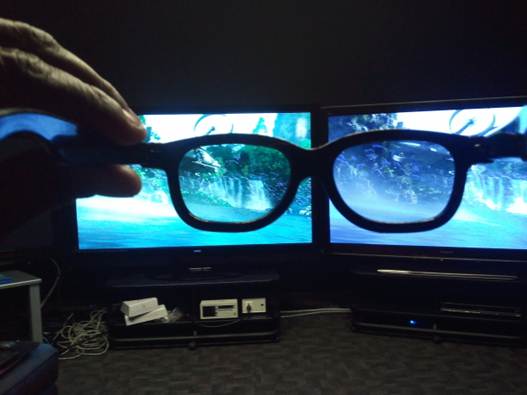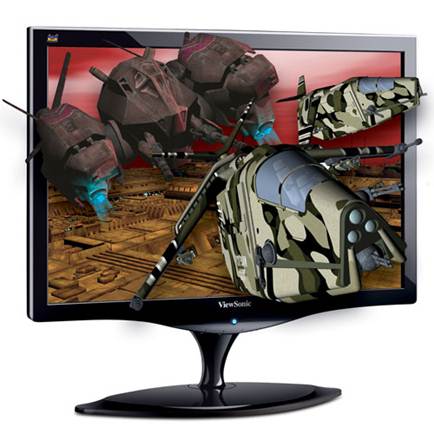What Technology Should You Look For?
We've mentioned passive and active
technologies, so we should explain the specific differences between them.
All 3D technology works by projecting two
slightly different images into your eyes, which your brain combines to form a
three-dimensional combination of the two in the same way our binocular vision
works. Both active and passive 3D achieve this effect, but by two different
means. (It's also possible to find 'glasses-free' 3D, such as in the Nintendo
3DS, but this has not yet become popular in PC monitors.)

Passive 3D is the cheaper of the two main
technologies, and involves using special lenses to filter out certain
polarizations of light. The monitor is adapted to display two different
polarizations, ensuring that two simultaneously displayed images are divided
into each eye by the glasses.
The advantages are that because the
technology requires no power, just a simple filter, the glasses are cheap, and
because the images are displayed simultaneously, you can see them at your
monitor's full frame-rate.
The main disadvantage is that because they
block a lot of light, the glasses will make the image considerably dimmer. You
can compensate by brightening the image manually, of course. There's also a
problem that because they display two images at once, you actually only get
half of the resolution on each, which can lead to a lower-quality combined
picture.
Active 3D (also called active shutter) is
the more expensive and newer iteration of the two. Rather than polarizing
light, active 3D monitors switch rapidly between the image for the left and
right eye. Only one is displayed at any given time. And the glasses, which are
powered, switch their lenses on and off to allow in only one image at a time
into the appropriate eye.

active
3D glasses
The advantage is that you get a
full-resolution, full-brightness picture with little to no bleed between the
two different images.
The disadvantage is that the frame-rate is
cut in half, which is why active 3D monitors must be 120Hz rather than the
standard 60Hz, and why the glasses are expensive and require their own power
source and a separate sensor to sync up the monitor and the shutters on the
glasses. Obviously, because they're more complicated, more can go wrong.
The choice of technology really depends on
which you can afford. Active arguably offers a better experience, but it's more
expensive with it. Passive is affordable but looks worse. If you're likely to
only have one person using the screen at any given time, we recommend active
3D. If you're likely to have multiple users, passive may be better, but
ultimately the tradeoff is yours to decide on.
Is Now the Right Time to Buy?
3D monitors have been dropping in price
fairly consistently for the last couple of years, and those drops show
absolutely no sign of abating. The first sub-$250 3D monitors arrived only
recently, and you can probably expect a sub-$150 3D monitor within a year.

The
new ViewSonic
In that sense, 3D monitor technology
follows a typical pattern for the computer industry. It's constantly getting
better, and you'll save more money the longer you wait. The question you have
to answer for yourself is whether you'll use the 3D capabilities once you have
them. If so, there's no huge reason to wait. If not, it's best to hold off.
There's also a chance, as standards begin
to emerge and normalize, that you could buy a 3D monitor that turns out to be
obsolete before the end of its lifespan. If you're keen to avoid this, we
recommend you seek out one compatible with NVidia's 3D Vision kits, since
they're fast becoming the industry standard after signing deals with various
manufacturers.
What Are The Technical Constraints?
Despite what you might think, there are
very few technical constraints that might prevent even an average computer
system from outputting a 3D signal.
The obvious bottleneck is the graphics
interface, but this isn't particularly likely to be an obstacle to anyone with
a recent PC. Any dedicated graphics card is more than powerful enough to output
a 3D signal. It's more important that the monitor is capable of interpreting
it.
The brand of graphics card you're using
does matter to an extent. NVidia has formed relationships with numerous
companies to create a line of products that are branded '3D Vision' and make
the process of setting up a 3D display into a simple one. There's no direct AMD
competitor to the NVidia 3D Vision brand at the moment, so if you're using an
AMD card you'll need to take extra steps to view 3D signals on an active
display. It's not simple, but it is possible.
If you're using a passive display, however,
you can use both AMD and NVidia cards with equal ease. This normally involves
installing a software component called TriDef Ignition, which is bundled with
3D monitors and allows you to set up a 3D display using either model of
graphics card. It's also worth mentioning that you can improve the performance
of 3D visuals by adding a second graphics card to your system and running them
in SLI/CrossFireX configuration.
Regarding high-definition movies, do be
aware that the limitations of copy protection mean you can only view Blu-ray
video over digitally protected connections such as HDMI. If you're trying to
watch a 3D film over a VGA connection, you won't get the full picture, as it
will be automatically downscaled to standard definition! mm
|
What's The Alternative?
If you don't want a 3D monitor, there's
very little you can do that has any chance of replicating the same effect.
For obvious reasons, of course, because the technology is either available in
your monitor or it isn't, there's no other way to get it.
That said, certain games do have
anaglyphic 3D modes that work with any monitor, while media players such as
the Stereoscopic Player (available at www.3dtv.at) will allow you to
view certain 3D video files using anaglyphic glasses. In case you're
unfamiliar with the term, these are the typical red/green (or red/blue)
glasses that for decades represented the height of 3D technology.
Of course, anaglyphic 3D hasn't exactly
improved over the years; it's just easier for modern systems to display. You
can forget about seeing anything in its original color while using such
glasses, and prepare yourself for headaches and distorted vision as your
brain attempts to compensate for two different-colored visual inputs.
The poor quality of anaglyphic 3D will
largely defeat the point of watching or playing a high-end 3D game or viewing
high-definition movies in 3D, because there's no way you'll be getting a good
experience while doing so, but if you want 3D without a 3D monitor, you don't
really have any other choice. Just don't think that we're recommending it as
a sane course of action.
Of course, if you're just interested in a
high-end monitor, rather than a 3D one, you have plenty of options available.
For the price of a 3D monitor, you can buy a normal LCD screen that performs
beyond your wildest dreams!
Although any LCD monitor over $323.1 can
be considered high-end, the best kind to look for are those with IPS panels,
which have better color replication and wide viewing angles. Just make sure
the latency is as low as possible if you're planning to use it for gaming or
watching video. It won't be 3D, but with picture quality that fine, you won't
care!
|